

展览名称
看,这个世界
——汪鹏飞的游走和记录
策展人
孙晓枫
艺术家
汪鹏飞
出品人
李揽月
开幕时间
2025年1月4日 15:00
展览日期
2025年1月4日—3月30日
开放时间
周二至周日 10:00—12:30/13:30—18:00
展览地址
桂林市七星区东边洲路与穿山东路交叉口西南100米井田CROFT
汪鹏飞是一个善于克服自身惰性的人。
汪鹏飞总在游走中寻求改变,寻求精神上的感应与塑造,寻求提升对于绘画的认知。各个地方的寓居,给他带来不同的观察和感受并诉诸绘画行动,被描状出来的人物、风景、静物,成为佐证汪鹏飞不同阶段精神状态的依据,保留了每个阶段特定的问题意识和思想进路,作品成为留给时间和记忆的信物,朴素的图像标识下的节点,留下一段段故事——与生活与艺术的种种纠葛。
创作于2007-2009年左右的《历史的回声》系列与《记忆之城》系列,为他早期重要作品。汪鹏飞以而立之年的担当感回溯了历史,并感应到历史在一个充满理想激情的青年身上的能量投射,历史的回声浑雄而悠远,年代的光华斑斑驳驳,曾经作为现场的历史空间被时间肌理化,人事褪尽,繁华不再,悲怆感凝固为壳。为历史中的时空造像,汪鹏飞成为一个负重前行的人。这一时期的风格,明显受到了德国表现主义大师安塞姆·基弗的影响,他的作品因深沉历史反思意识,视野宏大,构图上追求崇高感,有很强的精神张力,在无人之境的静默处辨析时代叠层中的惊雷丛起。汪鹏飞用仰视的角度,谦卑地立于历史的苍穹之下寻求着精神的升华与涤化。他在一则笔记中言道:“精神性的绘画是我的艺术理想。几年来,我用创作实践去表达对精神性绘画的理解。同时,在这个过程中,不断锤炼和提升自己的精神品格。”诚然,对英雄主义、浪漫主义、历史感与宗教性的追求让汪鹏飞面对着悲剧精神的感召,自上而下的观照,汪鹏飞孤零零地站在舞台中央,四周空旷,鸦雀无声,一束强光,重重地砸在汪鹏飞的身上。
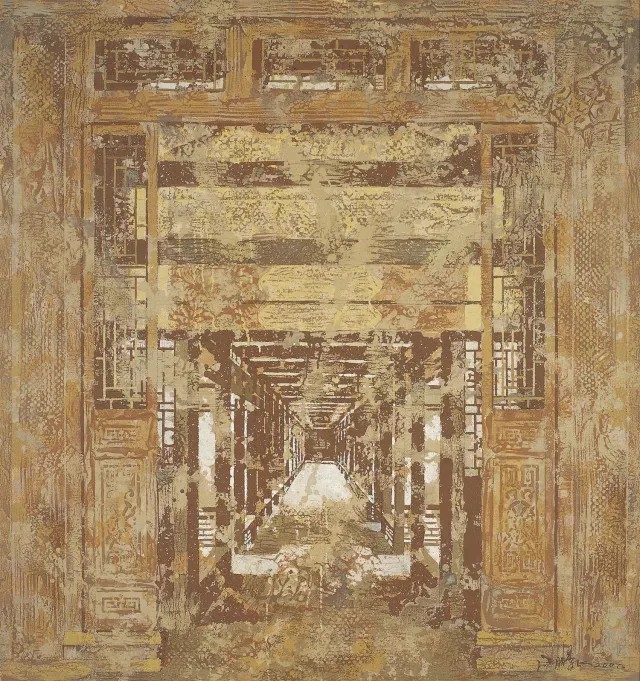
《历史的回声》之二,160cmx150cm,综合材料,2007
《殇》、《西口古道》、《黄河铁牛》、《雷峰塔》等作品,仍然属于汪鹏飞那个阶段绘画风格和路径的延续。饱满的情绪、凝重而带着镌刻力道的笔触,画面的质量感让注目之境有了纪念碑式的力量和压迫感。这一时期,他一直穿行于中原地区和大西北,走过山西,甘肃,陕西、河南等地,在右卫、云岗石窟留下了一系列作品。驻足与凝视成全了汪鹏飞的创作,所到之处,必心向往之,陌生、荒旷而苦寒的西北,汪鹏飞当做是精神的淬炼,与风沙为伴,在苍茫的历史尘埃中感应个人的渺小,用色彩、笔触捕捉洪荒之力,古城在视觉上呈现出来的团块感,像天上掉下来的石头,像地里长出来的石头,浑然混沌的天地一次次让汪鹏飞感受到神性与宗教感的降临。
自2014年到2024年十年的甘南写生,是汪鹏飞深化主题,确立个人风格,完善技法系统的重要阶段,这一时期,他与钟涵先生、李延洲先生和喻昌农多次去到甘南写生,有四五年更是自驾两三千公里,深入其中,记录甘南的生活、风土、宗教。汪鹏飞和甘南人一起生活,同吃同住,跟着牧民驱赶着成千上万的牛羊“转场”,感受着布满砂砾的路道上那些穿山过水长跪的人,看着牧民在市集上贩卖完牛羊后在归途中那种近似于道别和生命离弃的凝重与哀伤,甘南人信仰佛教,贩卖等于是间接的“杀生”,那种沉甸甸的原罪感和忏悔意识,一直郁结在甘南人的心中。他们粗粝的外表,饱含着一颗良善的因果之心,饱含着对众生的怜悯之情。“他们很多人的手像风化的树皮”汪鹏飞这样描述。
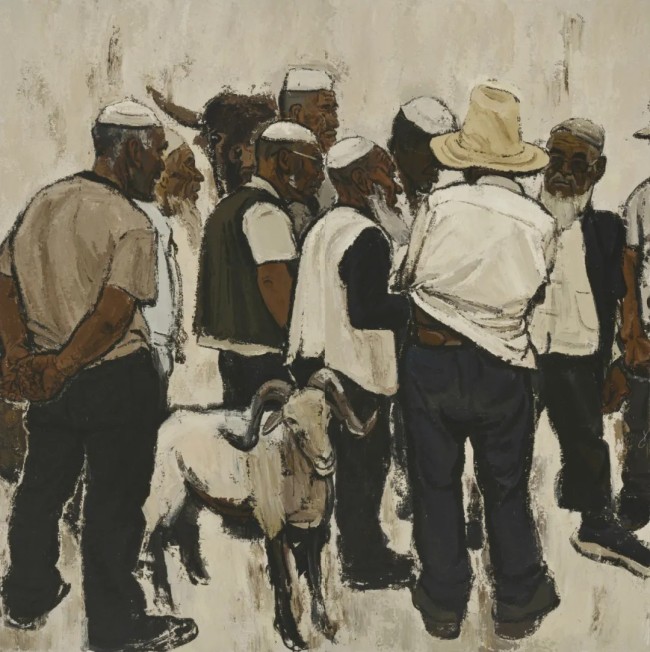
《黑白变奏曲》(局部),200cmx800cm,布面油彩,2020
甘南对于生活在大都市上海的汪鹏飞来说是一种异质的存在,形成了与他原来所处的上海、安徽等原生语境之间的巨大张力、在两极之间来去,汪鹏飞成了一个自渡的人。不同民族文化,宗教信仰渗化濡养成的不同的精神生活、生活方式、内容、路径与行为规范的强落差,反差极大的视觉构成,在汪鹏飞眼里,有一种“超现实”的意味。人迹稀渺的古城、游牧的列队、长跪的人、沉郁庄重的庙宇、戈壁和干涸的河床……一切都在缓慢地发生,那是一种长在大地的沉静体验,一切悬浮之物慢慢沉降到大地之中。汪鹏飞在甘南人的身上感受到沉下心活着,不求得一时的回报是善待生命后最大的回报。这种特定的时空体验,往往让人充满着强烈的宗教情绪,萌发出面对生死两极的终极追问。甘南时期,汪鹏飞借鉴了高更作品《我们是谁?我们从哪里来?我们到哪里去?》的追问方式,参照了蒋兆和先生《流民图》那种视觉构成和舞台式人物站位节奏完成《苍》(200CM×600CM)、《赛马会》(220CM×1000CM)、《黑白变奏曲》(200CM×800CM)等巨制,繁复的人物安排,中景和远景相互穿插的场景布陈,开阔的视角记录甘南人的生活,刻画出一种独特的甘南气质以及甘南人内在的精神品格。尺幅较小的《玛尼堆》(100CM×150CM)、《转场》(100CM×150CM)等作品,也是这个时期的重要作品,前者弥散着米勒作品《晚钟》式的宗教情绪,笔法拙重疏阔,后作则记录了转场时牛羊群的千军万马状,画面充满形式感,白和红的强烈对比中平衡了苍茫和热烈的矛盾。从甘南系列中不难观察到汪鹏飞对绘画问题、语言问题的一直思考,而他也不断地为自己的技法制造可能和参照,这是题材之外的另一条线索。
多年在甘南的观察、写生和生活的经验,汪鹏飞得以近距离地体验甘南生存中最为微弱的频动,用简括的手法为甘南精神造像,这是一个平视的角度,所有的情绪,对于宗教精神的理解,落实到活生生的族群,落实到个人每个容易被忽略的行为细节之中。
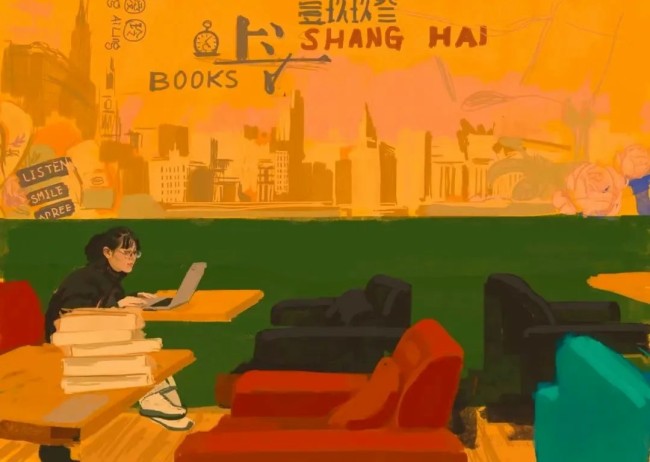
《西西弗书店》(局部),数码绘画,2023
2019年,汪鹏飞开始接触数码绘画,一开始是在手机上画,后来专门买了一个iPad用于绘画,数码的便捷性让他充分享受到绘画的愉悦,那种可以随时随地创作的轻盈感,即时判断,对于喜爱绘画的人来说,碎片化的时间可以得到充分利用,到哪画哪,敏锐反应,画面修改和补救的方便性吸引着他画了大量的作品。自从进入到数码绘画的状态中,汪鹏飞早期那种沉重的灰调不见了,替换的是明媚的阳光感,高饱和度的色彩,流畅而富有节奏的线条,绘画天赋里那种灵动的品质慢慢地呈露出来,绘画中的快乐被唤起以后,他开始新的思考,而2022年带着孩子自驾到甘南期间发生的困顿,也让他有了一种离开甘南题材的决定,技术在某种程度上会改变思维,改变看世界的方式和角度。绘画方式的改变,情感上的疏离终于让他在2024年彻底告别了甘南,他希望回到最熟悉的都市生活,回到周遭最熟悉的人和事物中,折返到日常与阳光。
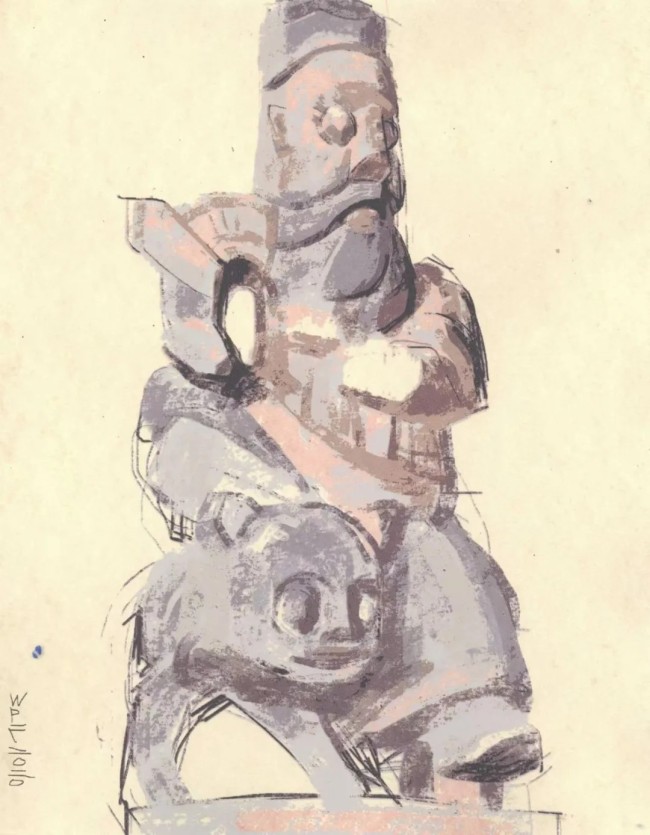
《古物7号》,30cmx23cm,丝网版画,2020
这个阶段,他接受了霍克尼关于“绘画意义从结果转移到过程,在于将自己的体验观察的过程保留下来”的论断,接受了霍克尼在评价毕加索绘画时的观点:“毕加索的特点是一切都取材于现实生活,他总是从真实的、往往是很普通的事物中去发掘主题。”这一点和齐白石的观点有内在契合的地方,齐白石也提到过他只画自己熟悉之物。这种接受是汪鹏飞自我解缚的“托词”,他需要从宏大叙事与传统绘画的标准模式(保守的)抽身而出,早期的题材提供的精神荡涤让绘画成为一种严苛的工作,主题规划和形象塑造的强目的性往往削弱和约束了个人的在场,风格化又极容易陷入现代主义和主题先行的圈套。打一个比方,当一件甘南题材的作品植入高度城市化的空间的时候,画面必然和现实生活拉开很大的距离,在审美上,在心理上,这让作品更像是一种猎奇、一种风俗画、一首在新潮文化的喧闹场所里沉默的牧歌,游牧文化和城市文化的剥离感强于融合感。这也是文化差异,发展时间落差带来的问题。
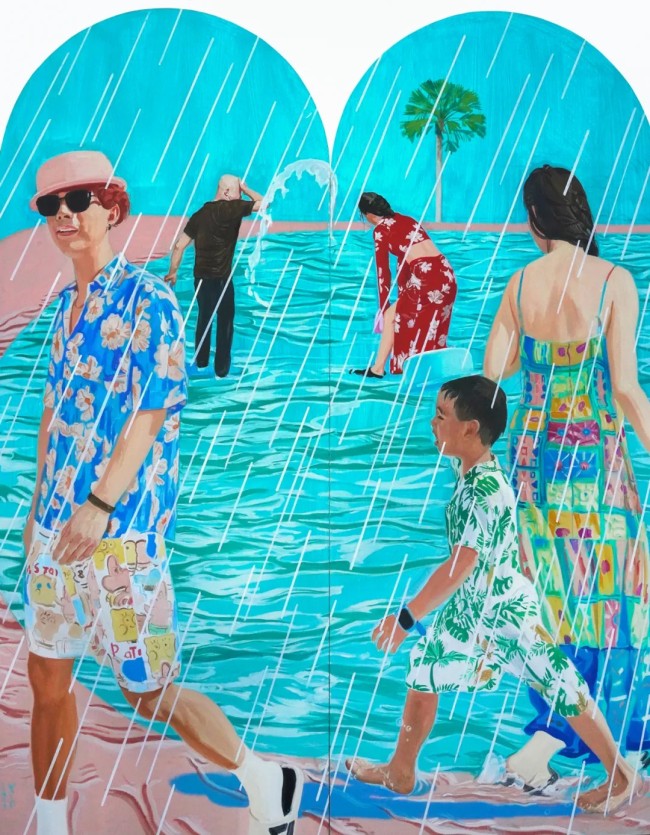
《水花》,200cmx160cm,布面油画,2024
汪鹏飞开始环视四周,用油画画他的学生,画身边朋友和他们置身的城市空间,(他在iPad已经画了几年)他观察着身边每个人的精神状态,记录下城市人在便利化的生活条件中那种疏散与浪漫,刻画出人群在城市高速发展的节奏与多媒体资讯分享与包围下的孤独感与陌生感。2024年夏天,因为岁末的展览项目,他在桂林做了十几天驻地创作,因为空间主人李揽月有多年留学英国的背景,他的井田空间是一个微缩版的城市空间,充陈着各种城市青年文化符号,汪鹏飞在杂陈的符号与充满工业光感的现场中内涌出表现的冲动,和进出空间的人交谈,画小鞠、画郑龙、画一白,既为空间存档同时也解决了城市题材如何集约化和系列化的问题。在一个相对密闭的交流空间中,有城市人的交往方式,也保留着生活交集以后的疏远感,未完成式的留白既是放空也是悬念。秋天时分,汪鹏飞去到西双版纳,这个充满民族风情的旅游胜地是城市文化供需的外延和补给,是城市文化与民族文化同构下的综合体。西双版纳的和煦与甘南的尘烟,一个在西南,一个在西北,构成了汪鹏飞视觉叙事中一次具有标识意义的转场。
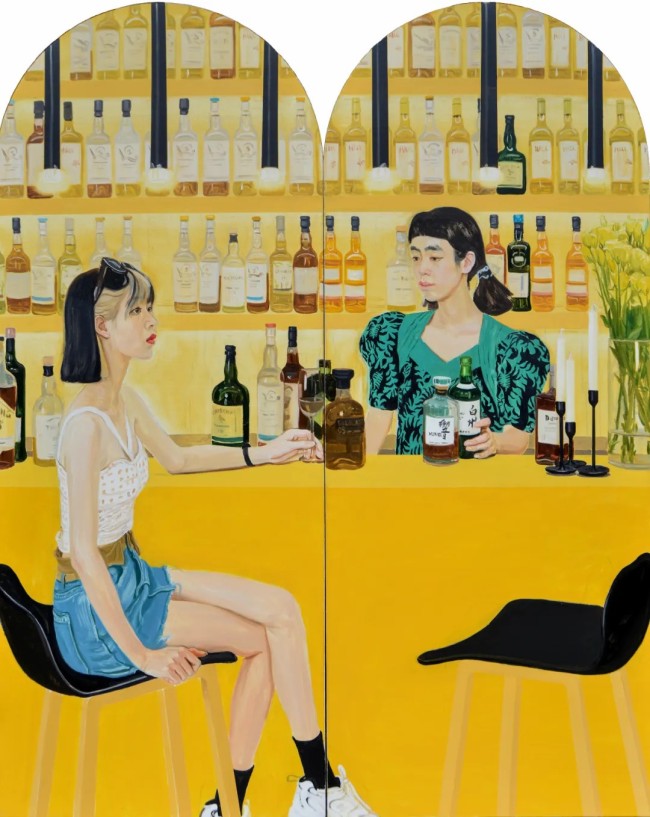
《吧台1号》,200cmx160cm,布面油画,2024
2024年对于汪鹏飞来说是起承转合的关键一年,他在做创作期间也用水彩轻松地勾画很多身边不起眼的日常之物,一个年份感的青花罐子,阿贝威士忌酒瓶、南澳岛的蚝壳、没有标签的梅子酒等等,当回到自我生命的内在体验,回到绘画本身,眼中的世界必然被抽离为一帧帧被形象充斥的图片,而一生的整体性,正是由这些微末的局部拼凑而成,像霍克尼拼贴出来的照片。
世界一直在那,好与坏,在于看与不看,在于看到什么,在于如何看以及个人与这个世界的相处之道。
(文/孙晓枫,《看,这个世界——汪鹏飞的游走和记录》,甲辰冬月完稿于南澳岛南山灶火)
Look At The World
——Wang Pengfei's Wandering and Records
Wang Pengfei is a person who possesses the rare ability to overcome his own inertia.
In his constant wanderings, he seeks transformation—both spiritual resonance and the evolution of his understanding of painting. The many places he has lived in have provided him with distinct perspectives and experiences, which he channels into his artistic endeavors. The figures, landscapes, and still lifes he depicts are not mere representations but become markers of the stages of his inner journey. They preserve the unique questions and thought processes of each phase, serving as relics left behind for both time and memory. Beneath the simplicity of these images lie nodes in time, each leaving behind a fragment of story—stories intertwined with life’s nuances and the ever-evolving discourse of art.
TheEchoes of History series andCity of Memory series, created around 2007-2009, stand as monumental works from his early period. In his thirties, with a sense of responsibility that came with age, Wang Pengfei looked back on history, feeling its energy reflected in the impassioned idealism of his youth. The echoes of history resonate deeply, their reverberations distant and profound, their former splendor now fragmented and faded. What was once a living, breathing historical space is now marked by the texture of time—humanity has receded, prosperity has vanished, and a sense of melancholic sorrow has solidified into an almost tangible shell. In crafting his depictions of this historical space-time, Wang Pengfei takes on the heavy burden of history, marching forward with it.
The style of this period is undeniably influenced by the German Expressionist master Anselm Kiefer, whose works, steeped in deep historical reflection, possess a grand vision and an aspiration toward the sublime. Kiefer’s compositions, full of spiritual tension, probe the layers of history, revealing the sudden and tumultuous eruptions buried within time’s silent corners. Wang Pengfei, too, adopts a similarly humble stance—looking upward, he places himself beneath the vast expanse of history, seeking spiritual purification and transcendence.
In a note he once wrote: “Spiritual painting is my artistic ideal. Over the years, I have used my creative practice to explore and express my understanding of spiritual painting. Simultaneously, through this process, I have continually honed and elevated my own spiritual character.” Indeed, his pursuit of heroism, romanticism, a deep sense of history, and even religiosity has led him to respond to the summons of tragic spirit. With a perspective from above, Wang Pengfei stands solitary at the center of the stage—his surroundings empty, silent. A single, powerful beam of light strikes down upon him, casting him into sharp relief.
Works such asGrief,The Ancient Path of Xikou,The Iron Ox of the Yellow River, andLeifeng Tower still belong to the continuation of the artistic style and path that marked this period of Wang Pengfei’s career. The intense emotions, heavy brushstrokes imbued with a chiseled power, and the tangible texture of the paintings imbue the scenes with a monumental quality and an overwhelming sense of gravity. During this time, Wang Pengfei traveled extensively through central China and the vast Northwestern regions—he passed through Shanxi, Gansu, Shaanxi, and Henan, leaving behind a series of works in places such as the Right Guard and the Yungang Grottoes. His moments of pause and contemplation became the very essence of his creation. Wherever he went, he was driven by a deep yearning. The alien, desolate, and bitterly cold Northwestern landscape served as a forge for his spirit. Accompanied by the wind and sand, he sought a personal sense of insignificance amidst the vast historical dust. With color and brushwork, he captured the primal force of nature. The ancient cities, with their visual mass, appeared like stones fallen from the sky or emerging from the earth. In this chaotic and indistinct world, Wang Pengfei repeatedly sensed the arrival of divinity and religious presence.
From 2014 to 2024, the ten years spent sketching in Gannan became a crucial period for Wang Pengfei to deepen his themes, solidify his personal style, and refine his technical system. During this time, he frequently traveled to Gannan with Mr. Zhong Han, Mr. Li Yanzhou, and Mr. Yu Changnong for field studies. For four or five years, he even drove thousands of kilometers on his own, immersing himself in the region to document the local life, customs, and religious practices. Wang Pengfei lived alongside the people of Gannan, sharing meals and lodging, and followed the herders as they drove thousands of cattle and sheep across the landscape. He experienced firsthand the lives of those who trekked across rocky paths, their bodies long bent from years of labor, and observed the heavy, sorrowful mood that lingered in the air when herders sold their cattle and sheep at the markets. The return journey, marked by a sense of parting and abandonment, seemed to carry a weighty undertone of existential finality. The people of Gannan, with their deep Buddhist faith, saw the act of selling livestock as an indirect form ofkilling, carrying with it an enduring sense of original sin and the need for repentance. This heavy, somber awareness of sin seemed to fester within the hearts of the people. Wang Pengfei described them as having “hands like weathered tree bark,” their rough exteriors hiding the deep compassion and karmic understanding of their hearts. They embodied a profound mercy for all living beings.
For Wang Pengfei, Gannan represented an existence entirely different from the urban life in Shanghai. It created a vast tension between the environments of his native places—Shanghai and Anhui—and the unfamiliar terrain of Gannan, a tension that pulled him back and forth between two extremes. In this space, Wang Pengfei became a person on a self-directed journey. The stark contrasts between different ethnic cultures, religious beliefs, and the resulting spiritual lives, lifestyles, values, and behavioral norms created a profound sense of disparity. This dissonance in visual composition, one that was so dramatically different from his own, struck Wang Pengfei as something “surreal.” The sparsely populated ancient cities, the herding lines of nomads, the long-kneeling figures, the solemn and dignified temples, the desolate Gobi and dried-up riverbeds—all these elements unfolded slowly, like a quiet experience rooted deeply in the earth. Everything that had once been suspended in the air slowly descended into the ground. Wang Pengfei felt in the people of Gannan a quiet, grounded way of living, one that did not seek immediate rewards but found the greatest reward in simply treating life with kindness.
This specific experience of time and space often evoked a strong sense of religious emotion in him, prompting ultimate questions about life and death. During his time in Gannan, Wang Pengfei drew inspiration from the questioning spirit of Paul Gauguin’sWhere Do We Come From? What Are We? Where Are We Going?and the visual composition of Jiang Zhaohua’sThe Picture of Refugees. This led him to create monumental works such as苍(Cang, 200CM x 600CM),赛马会(The Horse Race, 220CM x 1000CM), and黑白变奏曲(Black and White Variations, 200CM x 800CM), all of which explored complex arrangements of figures and scenes in which middle ground and distant views intermingled. These expansive works documented the lives of the people of Gannan and captured a unique Gannan temperament as well as the inner spiritual character of its people. Smaller works such as玛尼堆(Mani Pile, 100CM x 150CM) and转场(Transhumance, 100CM x 150CM) were also significant during this period. The former carries a religious emotionality reminiscent of Millet’sThe Angelus, with rough, sparse brushwork, while the latter captures the mass movement of cattle and sheep during the seasonal transhumance, with a visual rhythm full of formalism. In the strong contrast of white and red, the work balances the starkness and intensity of the land’s contradictions.From the Gannan series, one can easily observe Wang Pengfei’s ongoing reflections on issues of painting and language. He constantly sought new possibilities and references for his technique, a thread that runs parallel to the themes in his works.
Through years of observation, sketching, and living in Gannan, Wang Pengfei was able to closely experience the most subtle frequencies in Gannan’s existence. He used a simplified approach to portray the spirit of Gannan, taking a level gaze toward the people. All the emotions and his understanding of religious spirit were grounded in the daily lives of the local people, captured in the often overlooked details of their actions.
In 2019, Wang Pengfei began exploring digital painting. Initially, he started drawing on his phone, but later invested in an iPad specifically for his art. The convenience of digital tools allowed him to fully immerse himself in the joy of painting, offering a sense of lightness—the freedom to create anytime, anywhere, with the ability to make instant judgments. For someone passionate about painting, fragmented moments of time could be fully utilized. He could paint wherever he went, responding with keen sensitivity, and the ease of editing and revising was an attraction that led to an outpouring of works.Since immersing himself in digital painting, the heavy gray tones that defined his earlier works gradually disappeared, replaced by the brightness of sunlight, high-saturation colors, and flowing, rhythmic lines. The dynamic quality that had always existed in his artistic talent slowly emerged, and the joy of painting was rekindled. This new phase sparked fresh contemplation. However, during a road trip to Gannan with his child in 2022, some personal struggles led him to make the decision to move away from Gannan as a subject. Technology, in a certain sense, had changed his thinking, altering the way he viewed the world, the angles from which he observed it. The shift in his approach to painting and the emotional distance he felt finally led him, in 2024, to bid a complete farewell to Gannan. He longed to return to the familiar rhythm of urban life, to the people and things that surrounded him, to reconnect with the everyday, and with the sunlight.
During this period, he embraced David Hockney’s idea that “the meaning of painting shifts from the result to the process, in preserving the experience and the act of observation.” He also resonated with Hockney’s assessment of Picasso’s work: “Picasso’s uniqueness lies in how everything he painted was drawn from real life; he always sought themes from ordinary, everyday things.” This sentiment aligns deeply with Qi Baishi’s philosophy, who also mentioned that he painted only what he was familiar with. This acceptance became Wang Pengfei’s form of self-liberation, a justification for stepping away from grand narratives and the conventional standards of traditional painting. The spiritual cleansing offered by his early subjects had made painting a demanding, almost rigid endeavor. The strong sense of purpose in theme development and character shaping often diminished and constrained his personal presence within his work. Stylization easily fell into the trap of modernism and the tyranny of themes.To offer an analogy, when a work centered on Gannan is placed within the highly urbanized context of a city, the visual tension between the painting and the everyday world becomes stark. Aesthetic and psychological distances emerge, turning the work into something more akin to curiosity, to a genre painting, or a pastoral song that remains silent amidst the clamor of new cultural trends. The sense of disconnection between nomadic culture and urban culture is more pronounced than any sense of fusion. This dissonance is the product of cultural differences and the time gap in their respective developments.
In the autumn, Wang Pengfei traveled to Xishuangbanna, a tourist destination brimming with ethnic charm. Xishuangbanna served as an extension and supplement to urban culture, a composite space where city culture and ethnic traditions coexisted. The warmth of Xishuangbanna, with its gentle climate, contrasted sharply with the dusty, harsh environment of Gannan, located in the southwest and northwest respectively. This juxtaposition marked a pivotal shift in Wang Pengfei’s visual narrative, creating a significant transition in his artistic journey.
Wang Pengfei began to look around him, using oil paints to capture his students, friends, and the urban spaces they inhabited. (By this time, he had been painting on his iPad for several years.) He observed the mental states of those around him, documenting the sense of dispersal and romance that city dwellers experience amidst the convenience of modern life. He painted the loneliness and unfamiliarity that people felt in the face of the rapid pace of urban development and the overwhelming presence of multimedia information. In the summer of 2024, due to an exhibition project at the year’s end, Wang Pengfei spent over ten days doing artist residency work in Guilin. The space’s owner, Li Lanyue, who had spent years studying in the UK, had transformed the space into a miniature version of an urban environment, filled with symbols of youth culture. Amidst the clutter of these symbols and the industrial lighting, Wang felt a surge of creative impulse. He conversed with those coming and going through the space, painting portraits of Xiaoju, Zheng Long, and Yibai. These portraits not only served as a record of the space but also helped him tackle the challenge of simplifying and serializing the urban theme. In this relatively enclosed space, the interactions of city people were mirrored, while the sense of alienation and estrangement that often follows personal connections remained preserved. The unfinished spaces in his work represented both an emptiness and a lingering suspense.
The year 2024 became a key turning point for Wang Pengfei, a year of transitions and new directions. During his creative process, he also casually sketched everyday objects around him in watercolor—an old blue-and-white porcelain jar, an Ardbeg whisky bottle, oyster shells from Kangaroo Island, a bottle of plum wine without a label. Returning to the inner experience of his own life, returning to painting itself, the world in his eyes was inevitably reduced to frames of images, each filled with shapes and forms. The overall unity of life, he realized, is pieced together from these seemingly insignificant details—like a collage of photographs, as David Hockney had once done.
The world has always existed, in both its beauty and its flaws. Good or bad, it depends on whether we perceive it or not, and what we choose to perceive, how we see it, and the manner in which we choose to coexist with it.
(Sun Xiaofeng,Written in the winter of Jiachen Year, on the southern hill of Nanshan, Kangaroo Island)
(来源:角一)
策展人简介
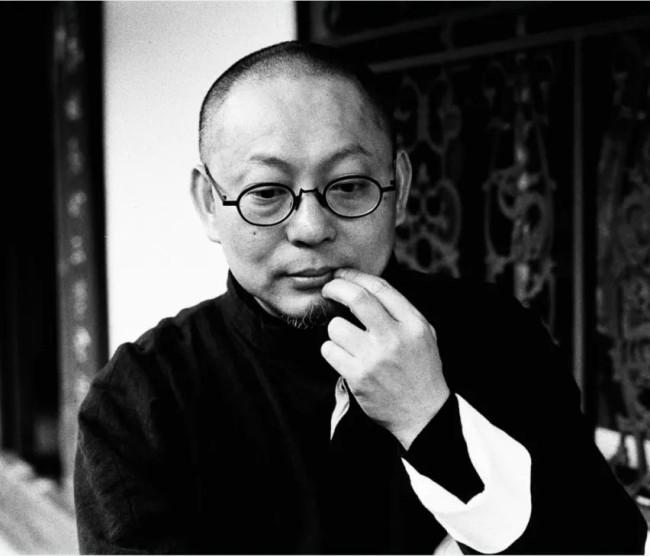
孙晓枫,独立艺术家、策展人、写作者和游食者。
画家简介
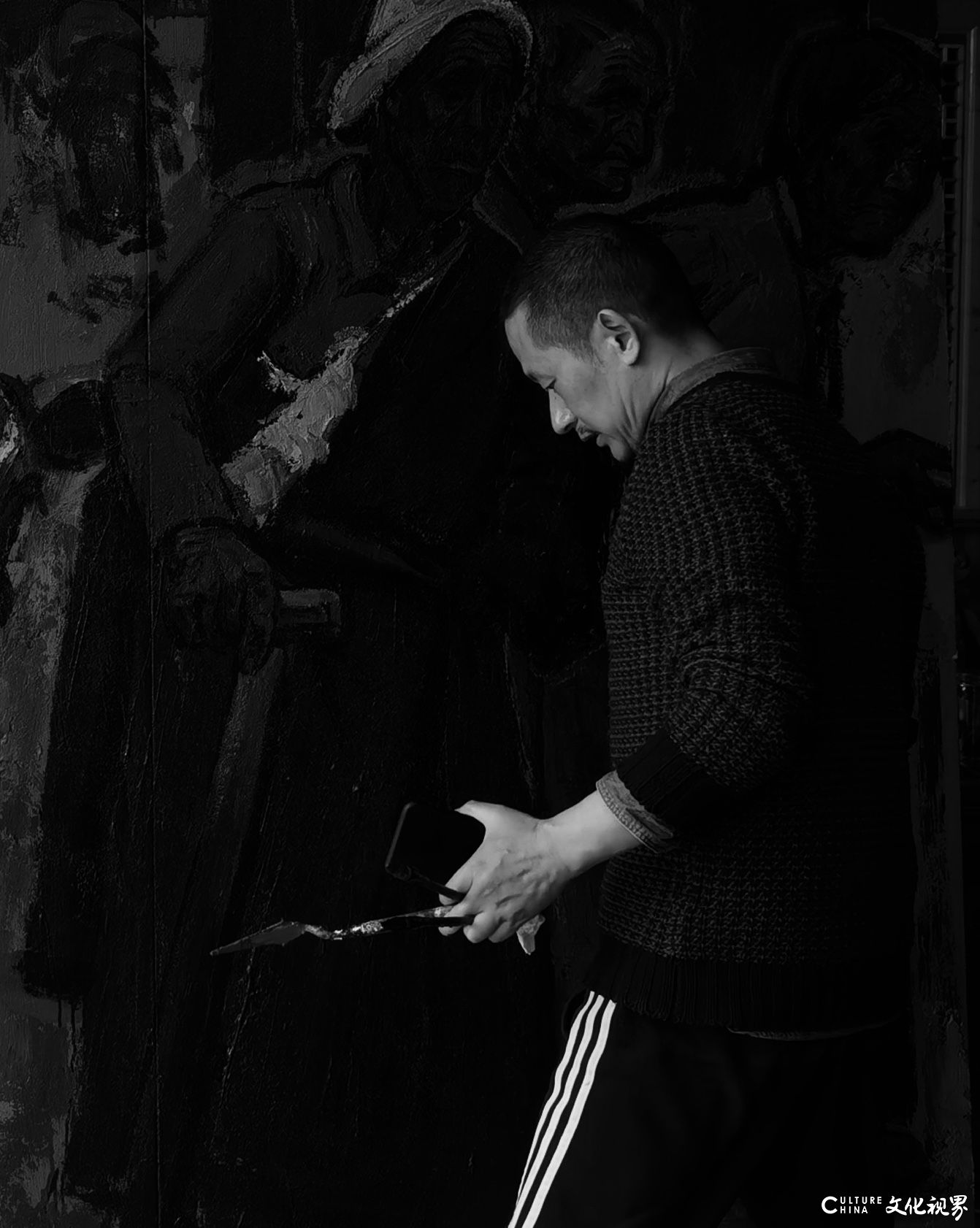
汪鹏飞,安徽省歙县人,现任教于广西艺术学院美术学院油画系,硕士研究生导师。国家一级美术师,中国美术家协会会员,70油画公社社员。
2006年毕业于中央美术学院油画本科
2007年结业于中央美术学院油画系助教研修班
2012年结业于中央美术学院油画高研班
2016年毕业于中央美术学院油画系,获艺术硕士学位
